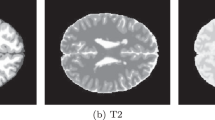Abstract
The analysis of medical image, in particular Magnetic Resonance Imaging (MRI), is a very useful tool to help the neurologists on the diagnosis. One of the stages on the analysis of MRI is given by a classification based on the Markov Random Fields (MRF) method. It is possible to find in the literature several packages to carry out this analysis, and of course, the classification tasks. One of them is the Insight Segmentation and Registration Toolkit (ITK). The analysis of MRI is an expensive computational task. In order to reduce the execution time spent on the analysis of MRI, parallelism techniques can be used. Currently, Graphics Processing Units (GPUs) are becoming a good choice to reduce the execution time of several applications at a low cost. In this paper, the authors present a GPU-based classification using MRF from the sequential implementation that appears in the ITK package. The experimental results show a spectacular execution time reduction being the GPU-based implementation up to 118 times faster than the sequential implementation included in the ITK package. Moreover, this result is also observed by reducing the total power consumption in a significant amount.
Similar content being viewed by others
References
Gravier G, Sigelle M, Chollet G (2000) A Markov random field model for automatic speech recognition. In: Proceedings of the international conference on pattern recognition (ICPR’00), vol 3. IEEE Computer Society, Los Alamitos, p 3258. ISSN:1051-4651
ITK - Segmentation & Registration Toolkit. http://www.itk.org/
Mardia KV (1988) Multi-dimensional multivariate Gaussian Markov random fields with application to image processing. J Multivar Anal 24:265–284
Duda RO, Hart PE, Stork DG (2000) Pattern classification, 2nd edn. Wiley-Interscience, New York
Li SZ (2000) Modeling image analysis problems using Markov random fields. In: Handbook of statistics, vol 20. Wiley, New York, pp 1–43
Besag J (1986) On the statistical analysis of dirty pictures. J R Stat Soc B 48:259–302
Feng W-c, Manocha D (2007) High-performance computing using accelerators. Parallel Comput 33:645–647
DeGroot M (1970) Optimal statistical decisions. McGraw-Hill, New York
McLachlan GJ (1992) Discriminant analysis and statistical pattern recognition. Wiley-Interscience, New York
Author information
Authors and Affiliations
Corresponding author
Rights and permissions
About this article
Cite this article
Valero, P., Sánchez, J.L., Cazorla, D. et al. A GPU-based implementation of the MRF algorithm in ITK package. J Supercomput 58, 403–410 (2011). https://doi.org/10.1007/s11227-011-0597-1
Published:
Issue Date:
DOI: https://doi.org/10.1007/s11227-011-0597-1




